Introduction
One of the most important environmental problems in recent decades is the logging and destruction of forests, which lead to deforestation of large areas and the disappearance of unique flora and fauna. The formation of deciduous and mixed deciduous-coniferous stands as a consequence of the felling of indigenous taiga forests on large areas of continuous logging during the XX century. It became a characteristic feature of the Northern forests (Мелехов, 1954; Побединский, 1973). The most significant logging operations using continuous logging in the Komi Republic (KR) occurred in the 1970s and 1990s, which led to transformations of taiga ecosystems (sometimes irreversible) into specific complexes of anthropogenic phytocenoses caused by the change of coniferous species to deciduous ones (Ильчуков, 2003).
As a result, to date, of the total stock of stands in the KR, 13.5% are accounted for by birch, 3.5% by aspen, and new areas regularly appear on which deciduous stands of after cutting origin are formed (Государственный доклад..., 2015). According to the new "Reforestation Rules", the Komi Republic is assigned to the Dvinsk-Vychegodsky taiga forest region, for which a number of features have been introduced during reforestation. In particular, target species are determined based on the needs of timber processing industries (Order..., 2016). Currently, when conducting logging, it is recommended transition to forest management with preservation of the forest environment and mosaic of forest landscapes on the basis of non-continuous and small-scale continuous logging (Ильина, Родионов, 2016). In the Komi Republic, there are already examples of such forest management – the model forest “Prilezye” (Паутов, 2013). The positive impact of mixed deciduous and coniferous stands on the commercial performance of wood in different management strategies is shown for Sweden, with the main condition being a certain ratio of deciduous and coniferous species (Fahlvik, 2015).
Reforestation processes take place in various directions and depend on a combination of forest growing conditions, the main of which are terrain, soil and hydrological features. In addition to natural conditions, the post-harvest recovery process is influenced by anthropogenic factors, such as logging technology and ongoing activities (Мелехов, 1954; Побединский, 1973; Паутов, Ильчуков, 2001). The relevance of the problem is due to the fact that the succession processes in the natural restoration of forests in fellings lead to changes in the structure and species composition of the emerging phytocenoses for a long time (Мелехов, 1954; Войнов, 1976). The purpose of the study was to identify growth features, structure, and quantitative estimates of stand, underwood and undergrowth in deciduous and mixed deciduous-coniferous plantations of post-harvest origin over a 10-year period.
Materials
Study deciduous and deciduous-coniferous plantations were carried out in Knyazhpogostsky district of the Komi Republic, in the vicinity of vil. Kyltovo (62°19'N, 50°55' E) on the territory of the Kyltovo district forestry of GU RK "Railway forestry" (sq 50, 51) in 2005-2015. Each year in the territory of the "Railway forestry" the size of natural forest regeneration is 74.1 % of the total amount of land that need in reforestation activities, artificial reforestation — 3.9 %, combined — 22 %. Natural reforestation in the forest area in most cases leads to the formation of deciduous stands (Лесохозяйственный регламент..., 2008). Researches on the territory of the forest area was carried out in post-harvest deciduous stands: in the birch-spruce young growth and middle-aged aspen-birch stands formed on the site of logging in the 1970s and 1990s. The choice of these objects was determined by the peculiarities of spruce renewal in the stands of the studied plantings. As is known, during post-harvest restoration, the spruce tree enters the first tier of the birch-spruce plantation to 40-70 years (Чупров, 1989), and the aspen-spruce tree – much later, to 90-100 years (Войнов, 1976).
Before cutting, in the place of young birch-spruce and middle-aged aspen-birch forests, the spruce blueberry-долгомошный and blueberry spruce forests grew with stand composition 8Е2Б, undergrowth – 10E, age 150-190 years (according to Kyltovo district of the GU RK "Railway forestry"). Soil – peaty-podzolic-are predominant.
The tree layer of birch-spruce young growth is complex and is represented by the dominant Betula pendulae, B. pubescens Ehrh., Picea obovata Ledeb., as well as single specimens - Populus tremula L., Pinus sylvestris L., Abies sibirica ledeb. (Fig. 1).
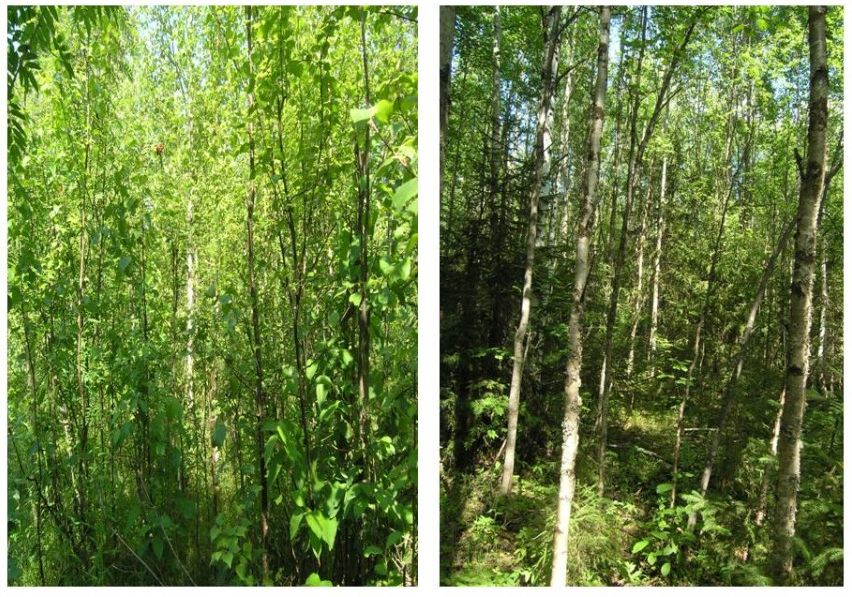

Fig. 1. 10- and 20-years-old birch-spruce young grown forest
The stand of aspen-birch plantation consists of Populus tremula, Betula pendula, B. pubescens, Picea obovata, and occasionally Abies sibirica (Fig. 2). The undergrowth of both plantations is from Salix caprea L., Sorbus aucuparia L., and single specimens of Rosa acicularis Lindl. (up to 0.5 m) and Lonicera pallasii L. (0.6 - 1 m).
Methods
On the territory of Kryltovsky forestry (50, 51 square meters), 6 permanent circular trial areas of 300 m2 each (3 in each type of forest) were laid. They were used to determine the number, species composition and quality of stands, underwood and undergrowth (Анучин, 1982). Each plantation was described by a complete set of taxational indicators according to the methodology adopted in the forest management (OСT, 1983).
Results
The actual state of the studied deciduous and deciduous-coniferous plantations, which is recorded using taxational indicators at a certain stage of their development, allows us to judge about the course of reforestation succession. According to the recalculation carried out in birch-spruce young growth in 2005, the composition of the stand (stock calculation) is 8Б2Еед.Сед.Ос, in 2015 - 7Б3Е+Сед. Ос, in aspen-birch – 5Ос4Б1Еед.Пх and 6Ос3Б1Еед respectively. The participation of birch and aspen in the studied stands is quite high in terms of the number of trees and can reach 92 % (Fig. 3, 4). At the same time, birch has a large share among the hardwoods in the composition of the studied stands – up to 74 %.
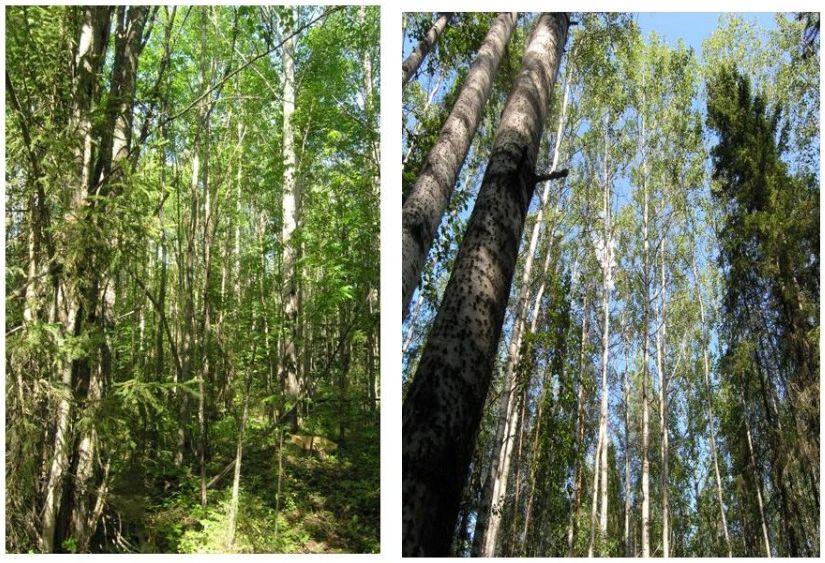

Fig. 2. 38- and 48-years-old aspen-birch plantation


Fig. 3. The percentage of tree species in birch-spruce young growth at the age of 10 and 20 years, % of the total number of trees in the forest stand
During a 10-year period in the stand of birch-spruce young forest growth the number of trees of all species increased. It should be noted that the number of spruce trees has increased by almost 1.5 times, and birch trees – by 2.5 times. However, according to Fig. 3, the percentage of spruce decreases, and birch – slightly increases. The share of pine and aspen in the young stock is insignificant (≤ 3 %).
In the aspen-birch plantation, the number of trees in the stand decreases over a 10-year period, with the exception of spruce, which becomes 2.5 times more. The participation of fir in the stand is insignificant (≤ 1 %) (m. Fig. 4).

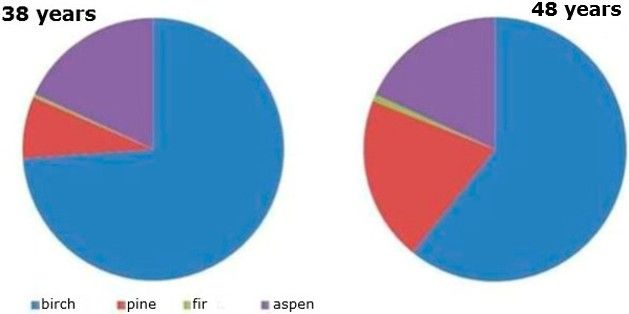
![]()
![]() F
F![]()
![]() ig. 4. The percentage of tree species in aspen-birch stands at the age of 38 and 48 years, % of the total number of trees in the forest stand
ig. 4. The percentage of tree species in aspen-birch stands at the age of 38 and 48 years, % of the total number of trees in the forest stand
In the underwood of birch-spruce young growth, the participation of deciduous species is quite significant – up to 85 % of the total number of reliable undergrowth. The spruce undergrowth is of medium density, represented mainly by small and medium-sized juveniles (Fig. 5), while at the age of 10-year-old – small, and in 20-year-old – mostly average in the category undergrowth. The number of reliable spruce undergrowth was 1.8 thousand spec./ha at 10-year-old, and 3.2 thousand spec./ha at 20-year-old. Reliable birch undergrowth in young growth at the age of 10 year was 11.7 thousand spec./ha, in 20-year-old – 10.9 thousand spec./ha. In Finland, in 50-year-old mixed birch forests, the number of spruce undergrowth reaches 2.6 thousand spec./ha (Hiemisto et al., 2012).
The number of birches in the juvenile undergrowth decreased by almost 1 thousand spec./ha over a 10-year period, which was largely due to the transition of large birch undergrowth to the forest stand. The share of young aspen, pine and fir in the studied undergrowth does not exceed 1% of each breed. According to quantitative accounting, at the age of 20 years, the composition of the undergrowth in the young growth (by the number of trees) is as follows: 8Б2Е едСедОс. In general, assessing the state of natural reforestation in birch and spruce young growth, it can be noted that, according to the "Rules of reforestation" (Приказ..., 2016), it proceeds quite successfully. However, the participation of spruce in the studied young growth is 3-4 times less than that of birch.
An assessment of the dynamics of the number of undergrowth during a 10-year period in the aspen-birch plantation showed that reforestation is quite satisfactory. The number of reliable undergrowth at the age of 38 was 10.5 thousand spec./ha, including 4.5 thousand spec./ha of spruce and 5.8 thousand spec./ha of birch. In the aspen-birch plantation, the proportion of aspen and fir undergrowth is small-less than 1-2 % of the total number of reliable undergrowth. At the same time, small and medium-sized spruce and large birch undergrowth predominate during the 10-year period (see Fig. 6). In general, the number of viable undergrowth for 10 years has decreased by 2 thousand spec./ha, while the number of reliable undergrowth of spruce and birch is reduced by 2 and 4 times, respectively. The ratio of viable young growth of spruce to birch changes significantly. At the age of 38 years, the dominant position is occupied by viable birch undergrowth, and after 10 years, spruce takes its place. As a result, by the age of 48, the composition of the undergrowth by the number of trees is 5Е4Б1ОседПх.

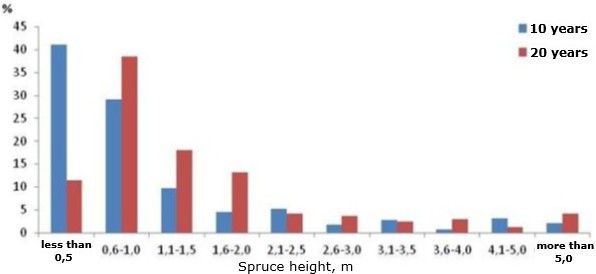
Fig. 5. The grouping of heights of spruce undergrowth in birch-spruce young forest at the age of 10 and 20 years, %
The total number of undergrowth, represented mainly by willow and rowan, in 2005 in birch-spruce young growth reached 14, in 2015 – 8 thousand spec./ha. It should be noted that the number of rowan specimen decreased slightly, and willow – 2 times, while the ratio of healthy trees increased. In the aspen-birch plantation, the total number of trees in the undergrowth in 2005 was 6, in 2015 – 3 thousand spec./ha. In the undergrowth a 10-year-old birch-spruce young growth, the number of willow trees is 2 times higher than that of rowan, at the 20-year-old – they are almost equal, in aspen-birch planting during 10 years, on the contrary, the amount of rowan decreased by half, and willow presented by small number of specimen, has not changed. In general, the undergrowth of the studied plantings is characterized by an increase in the percentage of healthy trees due to the natural drop-off of dry and shrinking trees.
Discussion
Changes in the composition of the stand during a 10-year period in the studied plantings led to an increase in the number of birch and spruce trees, and a decrease in aspen (see Fig. 3, 4). It should be noted that, despite the increase in aspen stocks in the aspen-birch plantation during a 10-year period, the number of trees by the age of 48 years decreased from 524 to 489 spec./ha. As was be previously shown, to 30-45 years, aspen reaches maximum growth and phytomass, to 50 years its mass relatively stabilized, and after 50 years it begins to "fall out" of the stand, which leads to a decrease in its mass (Тарасов и др., 2018). This trend has also been observed in current studies. The increase in the number of birch and spruce specimens is due to the transition of large undergrowth into the forest stand.
The share of birch in the population of birch-spruce young growth during the study period changed from 54 to 37 %, in aspen-birch – from 77 to 85 % of the total number of reliable undergrowth. Birch undergrowth for the entire study period was quite dense, reaching 12 thousand spec./ha. The birch undergrowth for 10 years has changed significantly both in quantity and in quality: the number of dry and shrinking specimens has increased, there was a natural loosening associated with the death of plants, large undergrowth has moved into the stand. The state of birch undergrowth largely reflects the stages of development of the studied derivative plantings.

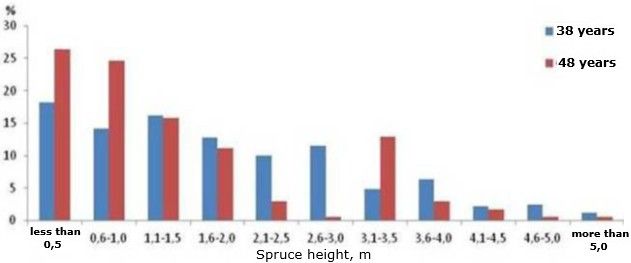
Fig. 6. The grouping of height of spruce undergrowth in aspen-birch stands at the age of 38 and 48 years, %
Despite the significant stock of aspen in the stand of aspen-birch planting, the participation of aspen undergrowth in plantations is insignificant (1-2 % of the total number of reliable undergrowth), there are no more than 100 specimens per 1 ha, and as of 2015, it is represented mainly by shrinking specimens less than 1 m high. This is due to the light-loving nature of the aspen and the obstacle of increasing shading from spruce undergrowth and moss cover for the development of its shoots. This allows to conclude that, despite the dominant position of aspen in the stand of this plantation, in the future its participation will gradually decrease. Pine undergrowth is observed only in birch-spruce young growth in small quantities. Its presence under the canopy of young growth is explained by a come flying of seeds from nearby fruit-bearing pine trees. Individual specimens of pine are mostly located in windows where the conditions for its survival are mostly favorable.
The change in the composition and quality of the undergrowth over a 10-year period allows us to estimate the ratio of the number of reliable undergrowth to its total number in the planting. In birch-spruce young growth, this ratio for spruce undergrowth increased from 88 to 93 %; for birch, pine, and fir, it has not changed much. In the aspen-birch plantation, this ratio for aspen and fir undergrowth decreases, spruce – practically does not change, and for birch it increases from 52 to 63 %. It can be assumed that in the birch-spruce young growth, the renewal of spruce under the canopy of the stand occurs more intensively than in the aspen-birch plantation. In general, the total number of undergrowth in the studied plantings decreased over a 10-year period. This is partly due to the transition of large undergrowth into the forest stand and natural thinning. As it is known, in the age of 20-40 years, the birch has an intensive growth in height, and up to 30-60 years – the maximum increase is in the diameter (Чупров, 1989). Another important reason is the completion of the crown closing phase in birch-spruce young growth at age of 10-15 years, which leads to increased competition between spruce and birch undergrowth (Ильчуков, 2003).
The decrease in the number of undergrowth in the studied plantings while the stand grows, is associated with a significant drop in undergrowth species, represented mainly by willow and rowan. The difference between the studied phytocenoses in the amount of willow per 1 ha is due to its species composition and the stage of successional development. In the young growth, the willow is represented by three species Salix caprea, S. pentandra, and S. philicifolia, which occupy different niches in the woody vegetation. As the stand is formed, Salix caprea, which has a tree-like shape, does not compete with the stand because of its light-loving nature, gradually disappears, and S. pentandra and S. philicifolia are more stable and grow under the canopy of the emerging stand in the form of biogroups consisting of several trunks. In the aspen-birch plantation, part of the willow fell away at earlier stages of succession due to the elimination of trunks. Therefore, at the time of research, the willow is represented by one species – Salix caprea, which is in competition with the aspen, which leads to a deterioration of its condition. The decrease in the number of rowan specimens is due to a number of its biological features: it reproduces well by root offspring, and the first 3-5 years after felling there is an increase in its number, which reaches a maximum up to 10 years, but in 10-12 years after felling it is replaced by more durable and fast-growing deciduous species – birch and aspen (Ковалев, 2012).
Conclusions
The features of changes in the structure and quantitative indicators of forest stand, underwood and undergrowth in the process of natural reforestation over during 10-year period in the middle taiga deciduous and deciduous-coniferous plantations of the Knyazhpogost district of the Komi Republic are considered. Different-aged deciduous and deciduous-coniferous stands formed on the cutting sites of blueberry-type spruce forests were studied. It was found that the natural reforestation of spruce under the canopy of deciduous trees is quite satisfactory. There was a more intensive renewal of spruce in the birch-spruce young growth compared to the aspen-birch plantings. It is revealed that the dominant role in the composition of hardwoods of the studied plantings belongs to the birch. Over the 10-year period, the share of spruce in the composition of the stand and viable undergrowth in plantations increased. In general, assessing the state of natural reforestation of birch-spruce young growth and aspen-birch plantations, it can be noted that it is quite successful. Studies have shown that the composition of the stand and undergrowth, as well as the nature of the renewal of the studied plantings, reflect the possibility of restoring the original spruce biocenoses in the long term.
References
Anuchin N. P. Forest taxation. M.: Lesn. prom-st', 1982. 552 p.
Chuprov N. P. Patterns of structure, growth of clean and mixed birch forests of the European North and increase their productivity. L., 1989. 35 p.
Fahlvik N., Ekӧ P. M., Petersson N. Effects of precommercial thinning strategies on stand structure and growth in a mixed even-aged stand of Scots pine, Norway spruce and birch in southern Sweden, Silva Fennica. 2015. Vol. 49. No. 3. P. 1–17.
Forestry regulations of the State Institution "Railway Forestry" of the Forest Committee of the Komi Republic. 2008. URL: http://www.komles.rkomi.ru/page/17998 (data obrascheniya 11.02.2010).
Hiemistӧ P., Korpunen H., Lauren A., Salomäki M., Uusitalo J. Impact and productivity of harvesting while retaining young understory spruces in final cutting of downy birch, Silva fennica. 2012. Vol. 46 (1). P. 81–97.
Il'chukov S. V. Dynamics of forest cover structure in clear-cuttings ( middle taiga subzone of the Komi Republic). Ekaterinburg, 2003. 120 p.
Il'ina O. V. Rodionov A. V. Selective logging in the North-West of Russia: state, opportunities and barriers to use, Principy ekologii. 2016. No. 1. P. 4–23.
Kovalev N. V. Resource potential and cenotic role of common mountain ash (Sorbus aucuparia L.) in forest ecosystems of Leningrad region: Abstract. SPb., 2012. 20 p.
Melehov I. S. The study of concentrated logging and reforestation in connection with them in the taiga zone, Koncentrirovannye rubki v lesah Severa: Sb. st. M.: Izd-vo AN SSSR, 1954. P. 5–47.
OST 56-69-83. Trial areas are forest inventory. Bookmark Method. M.: CBNTI gosleshoza SSSR, 1983. 60 p.
Order of the Ministry of Natural Resources of Russia dated June 29, 2016 No. 375 on the approval of the Forest Reforestation Rules. URL: http://ru/doc/prikaz-minprirody-rossii-ot-29-62016-n-375-ob-utverzhdenii/ (data obrascheniya 11.02.2019).
Pautov Yu. A. Il'chukov S. V. Spatial structure of derivative stands on continuous concentrated clearcuts in the Komi Republic, Lesovedenie. 2001. No. 2. P. 27–32.
Pautov Yu. A. Demonstration route "Forest and man: the history of relationship ("Chitaevo")". Syktyvkar, 2013. 29 p.
Pobedinskiy A. V. Felling and reforestation in the taiga forests of the USSR. M.: Lesn. prom-st', 1973. 200 p.
State report "On the state of the environment of the Komi Republic in 2015", Ministerstvo prirodnyh resursov i ohrany okruzhayuschey sredy RK GBU RK «TFI RK». Syktyvkar, 2015. URL: http://mpr.rkomi.ru/left/gosdoklad (data obrascheniya 11.02.2019).
Tarasov S. I. Pristova T. A. Bobkova K. S. Dynamics of phytomass of the stand of deciduous-coniferous phytocenosis of the middle taiga of the Komi Republic, Sibirskiy lesnoy zhurnal. 2018. No. 1. P. 50–58.
Voynov G. S. Formation and growth of aspen and aspen-spruce stands in the middle subzone of the European taiga and the basics of farming in them. M., 1976. 24 p.





 © 2011 - 2025
© 2011 - 2025